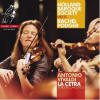Texte paru dans: / Appeared in:

Fanfare Magazine: 36:2 (11-12/2012)
Pour
s'abonner / Subscription information
Les abonnés à Fanfare Magazine ont accès aux archives du
magazine sur internet.
Subscribers to Fanfare Magazine have access to the archives of the magazine
on the net.
Channel Classics
CCSSA33412

0723385334125 (ID234)
Consultez toutes les évaluations recensées pour ce cd
~~~~ Reach all the evaluations located for this CD
Rachel Podger’s performance with the Holland Baroque Society of the first concerto of Antonio Vivaldi’s La Cetra, op. 9, promises a rich palette of timbres from the opening measures—assigned in this reading to organ and then, though only sparingly, to other instruments. Podger herself, playing a 1739 Pesarinus violin (try to look this up in your Funk and Wagnall’s; you’ll need the Internet even to get a line on this maker), produces a tone that’s not so tart and desiccated as those of some of her fellow period-instrument practitioners, and it sounds almost lyrically opulent in the slow movement of the First Concerto. Her energetic figuration sweeps the last movement along. The Second Concerto begins with a concise declamatory statement of the kind that Bach might have taken as a model in his own violin concertos, particularly the one in E Major. Inventive, plucked accompaniment by the society’s continuo group converts the Largo into a sort of captivating serenade. The Third Concerto features an opening movement punctuated by a suavely elegant tutti in the society’s performance and a slow movement with an almost languid solo flowing over a rhythmic accompaniment. The society hammers forcefully the Fourth Concerto’s bold opening strokes, which they answer with playfully quiet scampering. The contrasts provide a sharply etched portrait of the Venetian Master that escaped not only almost all of the 19th century but also much of the 20th (enhanced, depending on your view, by the ensemble’s percussive effects in the third movement). The Fifth Concerto brings similar contrasts, though not so pronounced. In this case, though, Podger contrasts heady, almost improvisatory-sounding flights of technical imagination with lyricism that seems to gaze forward into a new musical era. The Sixth Concerto, the first of two presenting the violin in scordatura (deliberately mistuned; the notes cite Michael Talbot’s suggestion that the effect might be a tribute to the Emperor Charles VI, to whom Vivaldi dedicated the set, in view of the practice of mistuning by the composers Heinrich Biber and Johann Schmelzer). Podger makes a great deal of the high tessitura in the first movement and the third as well.
The second part of the program begins with a percolating performance of the first movement of the Seventh Concerto, a lambently subtle one of its Largo, and an elegant one of the finale. The Eighth Concerto, in D Minor, sounds much darker in this reading, despite the chunky rhythms of its first movement and the spare but colorful and imaginative accompaniment by the society of its Largo. Violinist Judith Steenbrink joins Podger in the Ninth, a concerto for two solo violins and ensemble. They’re well matched in the ribbons of homophonic sound in the first and second movements, and play off each other effectively when opportunity arises in the third. The 10th Concerto features decisive strokes at the opening of its first tutti and chattering solo arpeggios over pedals scattered throughout the rest of the movement—passages in which Podger is smilingly engaging (think of Pietro Locatelli’s Harmonic Labyrinth and other cadenzas to his concertos, op. 3) as well as brilliant. The tracery pizzicatos of the accompaniment in the Largo cantabile underlie a mellifluous solo that leads to an alternately bustling and thumping finale. The 11th Concerto, more somber, receives an appropriately serious, determined performance of its first-movement tuttis, though hardly a grim one, spiced, in a mood-enhancing way, by jaunty solos. The 12th Concerto, like the Sixth (the end, in fact, of each half of the opus) calls for scordatura—in this case, with the G string tuned to B and the E string to D, facilitating the execution of technical passages in the concerto’s key of B Minor.
The society’s timbres, like Podger’s, seem more the result of fabric softener than starch, more balanced than extreme; the recorded sound transmits not only the tonal but also the dynamic range of their performances. Podger and the society recorded the complete op. 9 in two sessions, in September 2011 and January 2012, but the groupings of concertos (Nos. 1, 2, 5, 6, 7, and 10 and Nos. 3, 4, 8, 9, 11, and 12) with their slightly different personnel appear intermingled on the first and second CDs, which present the concertos in consecutive numerical order. Violinist Monica Huggett recorded the set with Nicholas Kraemer and the Raglan Baroque Players (Virgin 7243 5 62260 2 9, which has appeared on a four-CD set with the concertos of Vivaldi’s op. 8), but Podger’s (and the society’s) intoxicating timbral explorations probe far beyond Hugget’s (and her ensemble’s) more straightforward readings.
Those who admire Vivaldi’s violin concertos find in them a compendium of idiomatic gestures and techniques. But everyone should find as well a wealth of expression, lovingly recreated by Podger and the society. Recommended, urgently.
Cliquez l'un ou l'autre
bouton pour découvrir bien d'autres critiques de CD
Click either button for many other reviews


